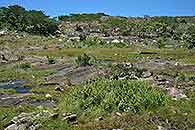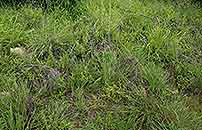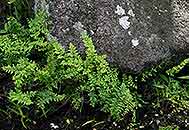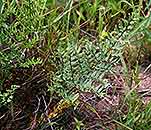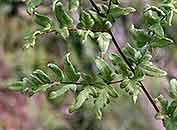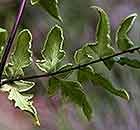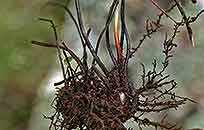Cheilanthes viridis (Forssk.) Sw. var. glauca (Sim) Schelpe & N.C. Anthony
Synonyms |
Pellaea viridis (Forssk.) Prantl var. glauca (Sim) Sim |
|---|---|
Common name |
|
Description |
Rhizome short, creeping, c.5 mm in diameter; rhizome scales lanceolate in outline, apex slowly tapering to a point, margin minutely toothed, up to 3 mm long, brown to rust-coloured with dark brown central stripe. Fronds monomorphic, tufted, erect to arching, blue to pale green, thinly coriaceous. Stipe up to 33 cm long, longer or shorter than the lamina, grooved, dark brown to blackish, shiny, set with scattered scales, more so towards the base. Lamina varying in size, shape and dissection; mostly 2-pinnate to 4-pinnatifid, lower pinnae slightly basiscopically developed, up to 20 cm × 8 cm, lanceolate to deltate or triangular in outline; pinnules ovate-oblong in outline, apex rounded to slightly pointed, margin entire to minutely crenate, both surfaces hairless; venation free, distinct; rhachis and secondary rhachis dark brown to black, deeply grooved with wings a paler chestnut colour, set with scattered, appressed hairlike scales, not pubescent in the axils. Sori marginal; indusium continuous, membranous, erose. |
Notes | May be mistaken for C. virides var. viridis or C. involuta. C. viridis var. viridis has a rhachis that is broadly grooved, the base of the secondary rhachis and petiolules are set with short hairs.
C. involuta var. obscura differs in having a rhachis that is broadly grooved, a dark chestnut-coloured stipe and veins that are hardly visible.
|
Derivation | viridis: green, glauca: grey-green; referring to the colour of the lamina. |
Habitat | Among rocks in woodland, in grassland and open outcrops, occasionally on the edges of forest or scrub. |
Distribution worldwide | Africa, Mauritius. |
Distribution in Africa |
Angola, Botswana, Kenya, Malawi, Mozambique, Namibia, South Africa, Swaziland, Tanzania , Uganda, Zambia, Zimbabwe. |
Growth form |
Lithophytic, terrestrial. |
Literature |
|
